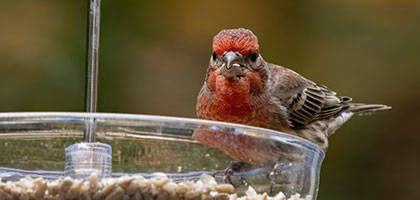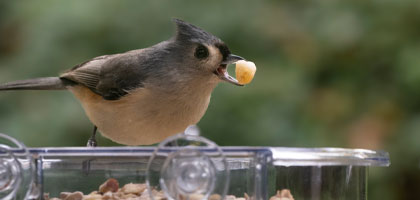Bird feeding is a popular hobby. It brings joy to many and helps us connect with nature.
One common question among bird enthusiasts is, "Do house sparrows eat nyjer seed?"
House sparrows are common birds in urban and suburban areas. They are known for their adaptability and varied diet.
Nyjer seed, on the other hand, is a popular bird feed. It's known for attracting finches and other small birds. But what about house sparrows?
This article aims to answer this question. We'll explore the diet of house sparrows, the appeal of nyjer seed, and how these two intersect.
Whether you're a seasoned bird watcher or a beginner, this guide will provide valuable insights. Let's delve into the world of house sparrows and nyjer seed.
Understanding House Sparrows and Their Diet
House sparrows are small, adaptable birds. They thrive in various environments, including cities and countryside settings.
These birds exhibit opportunistic feeding habits. They readily consume what's available, making them highly adaptable.
Their diet is diverse. It ranges from seeds to insects, reflecting their ability to thrive in urban areas. Understanding their diet helps manage bird feeders effectively.
What Do House Sparrows Typically Eat?
House sparrows have diverse dietary preferences. They adapt their diet depending on availability.
Typically, their diet includes:
- Seeds
- Fruits
- Insects
They favor seeds from garden plants and agricultural crops. But they will also consume insects and fruits when available.
The Nutritional Needs of House Sparrows
House sparrows require a balanced diet. This helps them maintain energy and survive in various environments.
They need protein from insects and fats from seeds. Both are crucial for their health and reproduction.
A varied diet ensures they receive vital nutrients. This makes them more resilient to environmental changes.
Nyjer Seed: A Popular Choice for Bird Feeders
Nyjer seed, also known as thistle seed, is a favorite among bird watchers. This tiny, black seed is rich in oil and calories.
Birders often use it to attract finches and other small birds. Its high energy content makes it popular for winter feeding.
Though pricier than other seeds, it's a preferred choice for many backyard bird enthusiasts. It ensures visits from a variety of small birds, enhancing birdwatching experiences.
What Is Nyjer Seed?
Nyjer seed originates from the plant Guizotia abyssinica. It's cultivated primarily in Africa and India.
This seed has gained popularity due to its high nutritional value. It's especially favored by certain bird species.
Despite its name, it bears no relation to thistles. Its unique characteristics make it distinct in the realm of bird feeding.
The Benefits of Nyjer Seed for Birds
Nyjer seed provides vital nutrients. Rich in oils, it offers excellent energy for birds, especially in colder months.
Small birds find it easy to consume due to its size. This makes it ideal for finches and similar species.
Its nutrient-rich profile supports birds' health and vitality, contributing to strong feathers and overall wellbeing. Providing such quality nutrition is crucial during challenging seasons.
Do House Sparrows Eat Nyjer Seed?
House sparrows are known for their adaptive feeding habits. Their diet includes seeds, fruits, and even insects.
This raises the question: Do they eat nyjer seed? Generally, they are less inclined towards nyjer.
This seed often attracts finches instead. However, house sparrows might explore it opportunistically if other food sources are scarce.
Interestingly, reports vary on their interest in nyjer seed. Not all sparrows exhibit the same feeding behavior.
House Sparrows' Feeding Behavior with Nyjer Seed
House sparrows possess strong beaks suited for larger seeds. Nyjer seed, being small, doesn't naturally appeal to them.
However, they can be opportunistic feeders. If nyjer seed is readily available, they might sample it.
Yet, they typically favor more accessible or familiar food. Larger seeds tend to be more aligned with their preferences.
Reports from Bird Feeding Communities
Birding communities have mixed observations about house sparrows and nyjer seed. Some note minimal sparrow activity at nyjer feeders.
Others report occasional sparrow visits, particularly during food shortages. These birds adapt based on regional and seasonal availability.
In conclusion, house sparrows may eat nyjer seed under certain conditions. Local feeder dynamics can greatly influence their behavior.
Nyjer Feeders and House Sparrows
Nyjer feeders are specifically designed to dispense tiny seeds. These feeders are often less appealing to larger birds.
House sparrows, with their larger size, find it difficult to use these feeders effectively. This design helps limit their access to nyjer seed.
However, sparrows might still attempt to access these feeders. Adjustments in feeder location can further deter them.
Design of Nyjer Feeders to Deter Larger Birds
Nyjer feeders typically feature small, narrow openings. This design serves to restrict access to smaller bird species.
These openings are just right for finches but challenging for sparrows. Thus, the design helps to limit larger birds from feeding.
Materials like mesh and tight-knit designs add another barrier. They discourage larger birds while welcoming smaller ones.
Attracting Desired Birds While Deterring House Sparrows
Successfully balancing bird feeding involves some strategy. Attracting finches while deterring sparrows requires careful planning.
Mixing feeder types can achieve this balance. Using nyjer feeders alongside other bird feeds is effective.
Here are some tips:
- Place feeders in different locations.
- Use specific seed mixtures less appealing to sparrows.
- Clean and monitor feeders to manage visitor behavior effectively.
Alternatives to Nyjer Seed for House Sparrows
House sparrows have a diverse diet. They consume various seeds, grains, fruits, and insects.
If you're looking to feed sparrows, consider more suitable options. Nyjer seed isn't typically their first choice.
Choosing seeds that align with their natural preferences will engage sparrows more effectively. It ensures they receive the nutrition they need.
Other Seeds and Foods Preferred by House Sparrows
House sparrows show a preference for certain foods. Larger seeds are often more attractive to them.
Here are some sparrow-friendly options:
- Cracked corn
- Millet
- Sunflower seeds
- Bread crumbs
These alternatives not only satisfy sparrows but also make your feeder more appealing to them. Offering these foods helps support their dietary needs.
Creating a Balanced Backyard Habitat
Crafting a balanced backyard environment is key. This means providing varied food sources and ample shelter.
Aim to nurture biodiversity while catering to specific bird preferences. Include a mix of native plants and seeds.
Such a habitat invites a range of birds, from sparrows to finches. This diversity creates a lively and harmonious backyard ecosystem.
Conclusion: Feeding House Sparrows Responsibly
Feeding house sparrows can be rewarding. However, it's crucial to do so responsibly.
Thoughtful feeding supports bird health and ecosystem balance. It also enhances bird watching experiences.
Balancing sparrows' needs with those of other birds is important. It fosters a thriving bird community in your backyard.
The Impact of Feeding Practices on Local Bird Populations
Feeding practices can significantly impact local bird populations. Providing food influences their behavior and movement.
Regular feeding can alter birds' natural foraging patterns. It also affects species diversity at feeders.
Understanding these impacts helps us feed sparrows wisely. It ensures we're supporting, not harming, local bird communities.
Tips for Responsible Bird Feeding
Responsible bird feeding involves more than just providing food. It requires attention to several factors.
Consider these tips to enhance your feeding practices:
- Use clean feeders regularly.
- Provide fresh water sources.
- Offer a variety of seeds.
Prioritizing these principles safeguards birds' health and habitats. It enriches your bird feeding efforts, promoting a healthy backyard environment.




